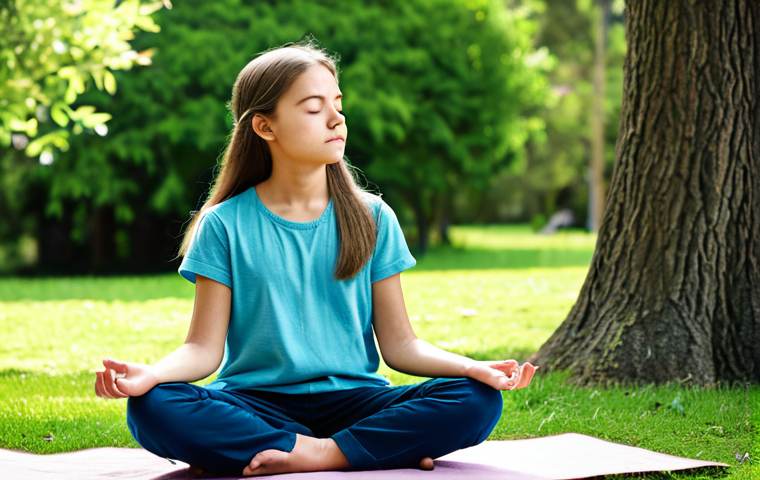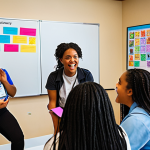Okay, here’s the blog introduction:The journey of guiding adolescents through their formative years is a deeply rewarding one, filled with unique challenges and triumphs.
As a youth counselor, I’ve witnessed firsthand the transformative power of group counseling sessions. Picture a space where teens, often grappling with similar anxieties and uncertainties, find solace and strength in shared experiences.
I’ve seen shy smiles blossom into genuine laughter and guarded hearts open to vulnerability and trust. These sessions are more than just talk; they’re a dynamic blend of evidence-based strategies and heartfelt connection.
The field of youth counseling is rapidly evolving. According to recent trends, there’s a growing emphasis on incorporating digital tools and platforms to enhance engagement and accessibility, especially for teens who are more comfortable communicating online.
AI-powered platforms are also emerging, offering counselors valuable insights into group dynamics and individual needs, although the human touch remains irreplaceable.
The future of youth counseling will likely see a greater integration of technology to improve efficacy and reach. Let’s delve deeper into the world of youth counseling and group sessions in the lines below!
Navigating the Initial Stages of Group Counseling

Group counseling, especially in the initial phases, is like carefully planting seeds in a garden. You need to prepare the soil, nurture the seedlings, and protect them from the harsh elements.
One of the first things I do is establish clear ground rules. These aren’t just arbitrary regulations; they’re the bedrock of a safe and trusting environment.
I make sure the teens understand the importance of confidentiality – what’s shared in the group stays in the group. I also emphasize respect, encouraging them to listen without judgment and to value different perspectives.
I remember one session where a conflict arose between two teens who had very different viewpoints on a sensitive topic. Instead of letting it escalate, I guided them to listen to each other’s experiences and to find common ground.
By setting these boundaries early on, we create a space where vulnerability is encouraged and growth is possible. It’s also essential to make sure the teens understand that group counseling is a collaborative effort, where each member is responsible for contributing to a positive and supportive atmosphere.
Building Rapport and Trust
Building rapport and trust in group counseling is like constructing a sturdy bridge – it takes time, effort, and the right materials. One of the most effective ways to foster connection is through icebreaker activities.
These aren’t just games; they’re carefully designed exercises to encourage interaction and self-disclosure. For instance, I often use the “two truths and a lie” activity, where each teen shares three statements about themselves, two of which are true and one is a lie, and the others have to guess which one is false.
This activity is not only fun but also helps the teens learn more about each other and build a sense of camaraderie. It also gives me insight into each teen’s personality and communication style.
Another technique I use is to share my own experiences and vulnerabilities, which helps the teens see me as a fellow human being, rather than just an authority figure.
By modeling openness and honesty, I create a safe space where the teens feel comfortable sharing their own struggles and triumphs. I recall one session where a teen who had been withdrawn and reluctant to participate opened up about a personal challenge after I shared a similar experience from my own life.
That moment of connection was a turning point for the entire group.
Addressing Initial Anxieties and Resistance
Addressing initial anxieties and resistance in group counseling is like navigating a maze. You need to be patient, observant, and adaptable. Many teens are initially hesitant to participate in group counseling, often due to fear of judgment, discomfort with sharing personal information, or skepticism about the process.
I address these concerns head-on by normalizing these feelings and reassuring them that it’s okay to feel apprehensive. I also emphasize the benefits of group counseling, such as gaining new perspectives, developing coping skills, and finding a supportive community.
I often use humor to lighten the mood and create a more relaxed atmosphere. I remember one session where a teen who was clearly uncomfortable made a sarcastic remark about the whole process.
Instead of getting defensive, I acknowledged his feelings and made a lighthearted joke about it, which helped him relax and open up. Another technique I use is to involve the teens in setting the agenda for the sessions, which gives them a sense of ownership and control.
By addressing their concerns and involving them in the process, I can help them overcome their initial resistance and embrace the potential of group counseling.
Utilizing Creative Expression Techniques
Creative expression techniques are a powerful tool for unlocking emotions and promoting self-discovery in youth counseling group sessions. I’ve seen firsthand how these methods can help teens express themselves in ways that traditional talk therapy sometimes can’t.
One effective technique is art therapy. Providing a range of materials like paints, clay, and collage materials can allow teens to visually represent their feelings and experiences.
The process itself, rather than the final product, is what holds the most value. It’s a way for them to externalize internal struggles and gain new insights.
Music therapy is another excellent option. Listening to music together, discussing the emotions it evokes, or even creating original songs can be incredibly cathartic.
For teens who struggle to find the right words, music can be a bridge to deeper understanding and connection. Finally, role-playing exercises can help teens explore different perspectives and practice social skills in a safe environment.
By acting out various scenarios, they can gain confidence in handling challenging situations and develop empathy for others.
Art Therapy: Painting Emotions
Art therapy, specifically using painting as a medium, is like providing a canvas for unspoken emotions. I’ve found that many teens who struggle to articulate their feelings verbally can express themselves with remarkable clarity through art.
One approach I use is to ask the teens to paint their current emotional state using only colors and abstract shapes, without focusing on creating a realistic image.
This exercise allows them to tap into their subconscious and express feelings that they may not even be fully aware of. As they paint, I encourage them to notice the colors they choose, the textures they create, and the overall energy of their painting.
After they’re finished, we discuss their artwork, focusing on the feelings and meanings that emerge. This process can be incredibly revealing, helping the teens gain a deeper understanding of themselves and their emotions.
I recall one session where a teen who had been struggling with anxiety created a painting filled with dark, swirling colors. Through the process of creating and discussing her artwork, she was able to identify the root causes of her anxiety and develop coping strategies.
Music Therapy: Finding Harmony
Music therapy, specifically focusing on finding harmony, is like tuning into the rhythm of emotions. It’s about using music as a tool to explore, express, and regulate feelings.
One technique I use is to have the teens listen to a variety of musical genres and discuss how each genre makes them feel. This exercise helps them become more aware of the connection between music and emotions.
Another approach is to have the teens create their own playlists of songs that reflect their current emotional state. They can then share their playlists with the group and explain why they chose each song.
This exercise not only helps them express their feelings but also allows them to connect with others who may share similar musical tastes and emotional experiences.
I also incorporate songwriting activities, where the teens work together to create original songs that express their collective feelings or experiences.
This collaborative process can be incredibly empowering, helping the teens build a sense of community and shared purpose. I remember one session where a group of teens who had been feeling isolated and disconnected wrote a song about their struggles and triumphs.
The process of creating and performing the song brought them closer together and helped them realize that they were not alone.
Role-Playing: Stepping into Different Shoes
Role-playing exercises, specifically stepping into different shoes, are a powerful tool for building empathy and developing social skills. I’ve found that by acting out various scenarios, teens can gain a deeper understanding of different perspectives and learn how to navigate challenging social situations.
One approach I use is to present the teens with a real-life scenario that they might encounter, such as dealing with peer pressure or resolving a conflict with a friend.
I then assign each teen a role to play, encouraging them to fully immerse themselves in the character and think about how that person would feel and act in the given situation.
After the role-play, we discuss the experience, focusing on what they learned about the other person’s perspective and how they might handle the situation differently in the future.
This exercise helps them develop empathy and learn how to communicate more effectively. Another technique I use is to have the teens switch roles and play the part of someone they disagree with.
This exercise can be particularly challenging, but it also provides a valuable opportunity to see things from a different point of view and develop greater tolerance and understanding.
Addressing Conflict and Promoting Resolution
Conflict is an inevitable part of any group dynamic, and youth counseling sessions are no exception. Learning how to address conflict constructively is a vital skill for teens to develop.
One effective approach is to teach them the principles of active listening. This involves paying close attention to what the other person is saying, asking clarifying questions, and summarizing their points to ensure understanding.
It also means refraining from interrupting or judging and focusing on empathy and validation. Another valuable technique is teaching teens how to express their own needs and feelings assertively, without being aggressive or passive.
This involves using “I” statements to communicate their perspective, such as “I feel frustrated when…” rather than “You always make me feel…” Finally, it’s important to help teens develop problem-solving skills, such as brainstorming solutions, evaluating the pros and cons of each option, and collaborating to find a mutually agreeable outcome.
Active Listening Techniques
Active listening techniques are the cornerstone of effective communication and conflict resolution. It’s about truly hearing what the other person is saying, both verbally and nonverbally, and responding in a way that shows you understand and value their perspective.
One key technique is to maintain eye contact and use body language that conveys attentiveness. This includes nodding, leaning in, and avoiding distractions like checking your phone or fidgeting.
Another important technique is to ask clarifying questions to ensure you fully understand what the other person is saying. This might involve asking them to elaborate on a specific point or to provide more context.
Summarizing what the other person has said is another effective way to demonstrate active listening. This involves paraphrasing their main points in your own words and asking them if you’ve understood correctly.
Finally, it’s crucial to avoid interrupting or judging the other person, even if you disagree with their perspective. Instead, focus on empathy and validation, acknowledging their feelings and showing them that you understand their point of view.
“I” Statements for Assertive Communication
Using “I” statements for assertive communication is a powerful tool for expressing your needs and feelings in a clear and respectful manner. Instead of blaming or accusing the other person, “I” statements focus on your own experience and how their behavior is affecting you.
The basic formula for an “I” statement is: “I feel [emotion] when [behavior] because [reason].” For example, instead of saying “You always interrupt me and it’s so rude,” you could say “I feel frustrated when I’m interrupted because it makes it difficult for me to share my thoughts and ideas.” This approach is less likely to provoke defensiveness and more likely to lead to a productive conversation.
When using “I” statements, it’s important to be specific about the behavior that is affecting you and to explain why it’s causing you to feel a certain way.
It’s also important to avoid using judgmental language or making assumptions about the other person’s intentions. Instead, focus on your own experience and how you’re being affected.
Collaborative Problem-Solving
Collaborative problem-solving is a process of working together to find a mutually agreeable solution to a conflict. It involves brainstorming ideas, evaluating the pros and cons of each option, and collaborating to find a solution that meets the needs of all parties involved.
The first step in collaborative problem-solving is to define the problem clearly and to ensure that everyone understands what the issue is. It’s also important to identify the needs and interests of each party involved.
What are they hoping to achieve? What are their concerns? Once everyone understands the problem and the needs of each party, the next step is to brainstorm potential solutions.
Encourage everyone to share their ideas, without judgment or criticism. Once a range of solutions has been generated, the next step is to evaluate the pros and cons of each option.
Consider the potential impact on each party involved and the feasibility of implementing each solution. Finally, work together to choose the solution that best meets the needs of all parties involved.
This may involve compromise and negotiation, but the goal is to find a solution that everyone can agree on.
Promoting Self-Esteem and Positive Self-Image
One of the most crucial aspects of youth counseling is fostering self-esteem and a positive self-image. Adolescence is a time of significant physical, emotional, and social changes, and it’s common for teens to struggle with feelings of insecurity and self-doubt.
I’ve found that focusing on strengths-based approaches can be incredibly effective. This involves helping teens identify their unique talents and abilities and encouraging them to focus on what they do well.
Another valuable technique is teaching teens about self-compassion. This involves treating themselves with the same kindness and understanding that they would offer to a friend.
Finally, it’s important to help teens challenge negative self-talk and replace it with more positive and realistic thoughts.
Strengths-Based Approaches
Strengths-based approaches are a powerful way to help teens build self-esteem and confidence. Instead of focusing on their weaknesses or shortcomings, this approach encourages them to identify and celebrate their strengths.
One way to do this is to ask them to create a list of their talents, skills, and positive qualities. What are they good at? What do they enjoy doing?
What do others admire about them? Once they’ve identified their strengths, encourage them to find ways to use those strengths in their daily lives. This might involve pursuing hobbies or interests that they enjoy, taking on leadership roles in their school or community, or simply using their strengths to help others.
It’s also important to help teens recognize the value of their strengths, even if they don’t seem particularly impressive. Everyone has unique talents and abilities, and it’s important to appreciate and celebrate those differences.
Practicing Self-Compassion
Practicing self-compassion is about treating yourself with the same kindness and understanding that you would offer to a friend. It involves recognizing that everyone makes mistakes, that everyone struggles at times, and that you are not alone in your experiences.
One way to practice self-compassion is to notice when you’re being self-critical and to challenge those negative thoughts. Instead of beating yourself up for making a mistake, try to treat yourself with kindness and understanding.
What would you say to a friend who made the same mistake? Another way to practice self-compassion is to remind yourself that everyone struggles at times.
It’s okay to feel sad, angry, or frustrated. These emotions are a normal part of the human experience. Finally, it’s important to remember that you are not alone.
There are others who have gone through similar experiences, and you can learn from their stories and find support in their company.
Challenging Negative Self-Talk
Challenging negative self-talk is a crucial step in building self-esteem and a positive self-image. Negative self-talk can be incredibly damaging, undermining your confidence and leading to feelings of anxiety, depression, and self-doubt.
One way to challenge negative self-talk is to identify the common patterns of negative thinking that you engage in. Do you tend to catastrophize, assuming the worst-case scenario?
Do you tend to personalize, blaming yourself for things that are outside of your control? Do you tend to filter, focusing only on the negative aspects of a situation and ignoring the positive?
Once you’ve identified your patterns of negative thinking, you can start to challenge those thoughts. Ask yourself if there’s any evidence to support the negative thought.
Is it really true? Is there another way to interpret the situation? Can you find any evidence to the contrary?
Replace the negative thought with a more positive and realistic thought.
| Technique | Description | Benefits |
|---|---|---|
| Art Therapy | Using art materials to express emotions and experiences. | Provides a non-verbal outlet, promotes self-discovery, and reduces stress. |
| Music Therapy | Using music to explore, express, and regulate emotions. | Enhances emotional awareness, fosters connection, and provides a sense of comfort. |
| Role-Playing | Acting out different scenarios to practice social skills and build empathy. | Develops communication skills, promotes understanding, and builds confidence. |
| Active Listening | Paying close attention to what others are saying and responding in a way that shows understanding. | Improves communication, builds trust, and resolves conflicts effectively. |
| “I” Statements | Expressing your needs and feelings in a clear and respectful manner. | Reduces defensiveness, promotes assertiveness, and facilitates productive conversations. |
| Collaborative Problem-Solving | Working together to find mutually agreeable solutions to conflicts. | Fosters cooperation, promotes creativity, and builds stronger relationships. |
| Strengths-Based Approaches | Identifying and celebrating individual strengths and talents. | Builds self-esteem, enhances confidence, and promotes a positive self-image. |
| Self-Compassion | Treating yourself with kindness and understanding, especially during difficult times. | Reduces self-criticism, promotes emotional resilience, and fosters self-acceptance. |
| Challenging Negative Self-Talk | Identifying and challenging negative thought patterns to promote a more positive mindset. | Reduces anxiety and depression, enhances self-esteem, and improves overall well-being. |
Teaching Coping Mechanisms for Stress and Anxiety
Adolescence is a time of immense stress and anxiety. From academic pressures to social dynamics, teens face a multitude of challenges that can take a toll on their mental health.
As a counselor, it’s vital to equip them with effective coping mechanisms to manage these stressors. Mindfulness techniques, such as meditation and deep breathing exercises, can help teens stay grounded in the present moment and reduce anxiety.
Cognitive restructuring, which involves identifying and challenging negative thought patterns, can help them reframe stressful situations in a more positive light.
Finally, encouraging healthy lifestyle habits, such as regular exercise, a balanced diet, and adequate sleep, can significantly improve their ability to cope with stress and anxiety.
Mindfulness and Meditation
Mindfulness and meditation are powerful tools for reducing stress and anxiety and promoting overall well-being. Mindfulness involves paying attention to the present moment, without judgment or criticism.
It’s about being aware of your thoughts, feelings, and sensations without getting carried away by them. Meditation is a practice that can help you develop mindfulness.
There are many different types of meditation, but most involve focusing your attention on a specific object, such as your breath, a sound, or a visual image.
As you meditate, your mind will inevitably wander. The key is to gently redirect your attention back to the object of focus, without getting frustrated or discouraged.
Regular practice of mindfulness and meditation can help you become more aware of your thoughts and feelings, reduce stress and anxiety, improve your focus and concentration, and enhance your overall sense of well-being.
Cognitive Restructuring Techniques
Cognitive restructuring techniques are a powerful tool for challenging negative thought patterns and reframing stressful situations in a more positive light.
This involves identifying the negative thoughts that are contributing to your stress and anxiety, examining the evidence for and against those thoughts, and then replacing them with more positive and realistic thoughts.
One common technique is to ask yourself “What’s the evidence?” What evidence do you have to support your negative thought? What evidence do you have to contradict it?
Another technique is to ask yourself “What’s the worst that could happen?” What’s the worst possible outcome of the situation? How likely is it to happen?
And if it did happen, how would you cope? Finally, you can try reframing the situation in a more positive light. What are some of the potential benefits or opportunities that could arise from this situation?
What can you learn from it?
Importance of Healthy Lifestyle Habits
The importance of healthy lifestyle habits cannot be overstated when it comes to managing stress and anxiety. Regular exercise, a balanced diet, and adequate sleep are all essential for maintaining both physical and mental health.
Exercise has been shown to reduce stress hormones, improve mood, and boost self-esteem. A balanced diet provides your body with the nutrients it needs to function properly, which can help improve your energy levels and reduce stress.
Adequate sleep allows your body to rest and repair itself, which can improve your mood, concentration, and overall well-being. In addition to these three key habits, it’s also important to avoid excessive alcohol consumption and drug use, as these can worsen stress and anxiety.
Transitioning to Independence and Future Planning
As teens approach adulthood, it’s crucial to guide them in transitioning to independence and planning for the future. This involves helping them develop essential life skills, such as budgeting, time management, and problem-solving.
It also involves exploring their interests, values, and goals and helping them make informed decisions about their education, career, and personal life.
Providing opportunities for them to gain experience through internships, volunteer work, or part-time jobs can also be incredibly valuable. Finally, it’s important to encourage them to build a strong support system of family, friends, and mentors who can provide guidance and encouragement as they navigate this transition.
Developing Essential Life Skills
Developing essential life skills is crucial for teens as they prepare to transition to independence and adulthood. These skills include budgeting, time management, problem-solving, communication, and decision-making.
Budgeting involves learning how to manage your finances, track your expenses, and save money. Time management involves learning how to prioritize your tasks, set goals, and manage your time effectively.
Problem-solving involves learning how to identify problems, brainstorm solutions, and evaluate the pros and cons of each option. Communication involves learning how to express yourself clearly and effectively, both verbally and in writing.
Decision-making involves learning how to weigh your options, consider the potential consequences, and make informed choices.
Exploring Interests, Values, and Goals
Exploring interests, values, and goals is a crucial step in planning for the future and making informed decisions about your education, career, and personal life.
What are you passionate about? What do you enjoy doing? What are your values?
What do you believe is important in life? What are your goals? What do you want to achieve in the future?
Asking yourself these questions can help you gain a better understanding of yourself and what you want out of life. It can also help you identify potential career paths that align with your interests, values, and goals.
Once you have a clearer sense of your interests, values, and goals, you can start to explore different educational and career options and make informed decisions about your future.
Building a Strong Support System
Building a strong support system is essential for teens as they navigate the transition to independence and adulthood. A strong support system can provide guidance, encouragement, and emotional support during challenging times.
This support system can include family members, friends, mentors, teachers, counselors, and other trusted adults. It’s important to cultivate these relationships and to seek out support when you need it.
Don’t be afraid to ask for help. It’s also important to be a supportive friend and family member yourself. Offer your help and support to others when they need it.
Building a strong support system is an investment in your own well-being and can help you navigate the challenges of life with greater resilience and confidence.
Navigating the complexities of youth counseling is no small feat, but armed with empathy, practical techniques, and a genuine desire to help, you can make a profound difference in the lives of teens.
Remember, it’s about creating a safe space, fostering self-discovery, and equipping them with the tools they need to navigate the challenges of adolescence and step confidently into the future.
In Closing
As we wrap up this guide, remember that the journey of youth counseling is one of continuous learning and growth. Every teen is unique, and what works for one may not work for another. Keep experimenting, keep learning, and never lose sight of the profound impact you can have on the lives of young people.
By consistently fostering a safe, supportive environment, we empower them to become more resilient, confident individuals ready to face the world.
Remember to adapt and adjust your methods to best meet the unique needs of the teens you work with, and continue to prioritize their well-being above all else.
Wishing you all the best in your counseling endeavors, and may you continue to make a positive impact on the lives of our youth.
Helpful Tips to Know
1. Leverage School Resources: Connect with school counselors and psychologists for referrals and collaborative support. Schools often have programs or resources specifically tailored to the needs of adolescents, which can be a great starting point or additional support system for the teens you’re working with.
2. Community Partnerships: Partner with local youth organizations and community centers to broaden your reach and provide additional resources. Building connections with these organizations can help you offer a wider range of support services to teens, such as mentoring programs, recreational activities, and educational workshops, enhancing their overall well-being.
3. Digital Tools and Apps: Utilize mental health apps and online resources to supplement in-person counseling. There are many evidence-based apps designed to help with mindfulness, anxiety management, and mood tracking. These can be a valuable tool for teens to use between sessions, providing continuous support and self-help strategies.
4. Parental Involvement: Encourage parental involvement in the counseling process, while respecting the teen’s confidentiality. Engaging parents can provide a more comprehensive understanding of the teen’s challenges and support system. However, it’s crucial to establish clear boundaries and ensure the teen feels safe and respected throughout the process.
5. Continuing Education: Stay updated on the latest research and best practices in youth mental health. Attend workshops, conferences, and webinars to enhance your skills and knowledge. The field of mental health is constantly evolving, and staying informed will help you provide the most effective and evidence-based support to the teens you serve.
Key Takeaways
Focus on building a safe and trusting environment from the outset.
Incorporate creative expression techniques to unlock emotions and promote self-discovery.
Teach conflict resolution skills, emphasizing active listening and assertive communication.
Foster self-esteem and a positive self-image through strengths-based approaches and self-compassion.
Equip teens with effective coping mechanisms for managing stress and anxiety.
Guide them in transitioning to independence and planning for the future.
Continuously learn and adapt your methods to meet the unique needs of each teen.
Frequently Asked Questions (FAQ) 📖
Q: What are some practical tips for creating a safe and engaging environment in youth counseling group sessions?
A: From my experience, the key is establishing clear ground rules upfront. I always start by emphasizing respect, confidentiality, and active listening. Think of it like setting the stage for a play – everyone needs to know their role.
I’ve found that using icebreakers that encourage vulnerability, but aren’t too intimidating, work wonders. For example, “Share one word that describes how you’re feeling today” can get the ball rolling without putting anyone on the spot.
And seriously, don’t underestimate the power of snacks! A little bit of pizza or some cookies can go a long way in creating a relaxed atmosphere.
Q: How can counselors effectively address conflicts that arise during group counseling sessions?
A: Conflicts are inevitable, right? It’s all about how you navigate them. My approach is to act as a facilitator, not a judge.
I make sure each person gets a chance to speak without interruption and focus on helping them understand each other’s perspectives. “I” statements are your best friend here – encouraging teens to express their feelings and needs without blaming others.
One time, two teens were arguing fiercely about a minor issue, but after they cooled down and actually listened to each other, it turned out they were both feeling insecure about fitting in.
Addressing the underlying emotions can be a real game-changer.
Q: In what ways can technology be incorporated into youth counseling group sessions to enhance their effectiveness?
A: Technology can be a powerful tool, but it needs to be used thoughtfully. I’ve seen counselors successfully use online platforms for virtual check-ins between sessions, especially for teens struggling with anxiety or depression.
Interactive polls and quizzes can make learning about coping mechanisms more engaging. I’ve even experimented with using VR to simulate stressful social situations so teens can practice their skills in a safe environment.
However, it’s crucial to remember that technology is just a supplement, not a replacement for the human connection that’s at the heart of effective counseling.
Maintaining a balance and ensuring that tech enhances, rather than distracts from, the experience is key.
📚 References
Wikipedia Encyclopedia
구글 검색 결과
구글 검색 결과
구글 검색 결과
구글 검색 결과






